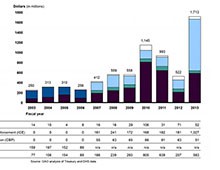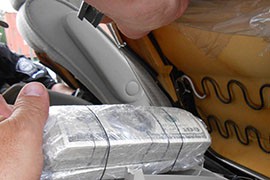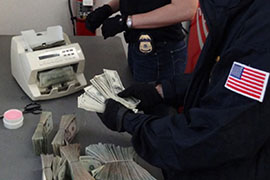Cronkite News has moved to a new home at cronkitenews.azpbs.org. Use this site to search archives from 2011 to May 2015. You can search the new site for current stories.
Report: Government seizures of assets have grown steadily
WASHINGTON – Government seizures of assets exceeded $1.7 billion in 2013, a nearly seven-fold increase in the Treasury Forfeiture Fund over a span of 10 years, according to a recent federal audit.
The March report by the Government Accountability Office said much of that increase could be attributed to a one-time 2013 windfall of $881 million that was forfeited to Immigration and Customs Enforcement as part of a money-laundering investigation.
But even without that money, the value of assets seized by federal authorities would have more than tripled over the decade, from $250 million in 2003 to $832 million last year.
While some may see that increase as a sign that police are working hard to “catch the bad guys,” said the author of the report, others worry that it shows authorities more focused on collecting funds than enforcing laws.
“What agencies have realized is that this is a significant revenue generator,” said Dick Carpenter, director of strategic research at the Institute for Justice. “In hard budgetary times, forfeitures is a way to supplement lean budgets.”
Repeated calls to several law enforcement agencies and organizations seeking comment were not returned.
The report was requested by Rep. Bennie Thompson, D-Miss., the ranking member of the House Homeland Security Committee who specifically wanted to look at the role of the Department of Homeland Security in the forfeiture fund and the “equitable sharing” of funds.
The audit said DHS agencies – including ICE, Customs and Border Protection and the Secret Service – accounted for 52 percent of the $7 billion deposited in the fund over the 10 years.
The money comes from assets seized during or after an investigation: cash, real estate, vehicles, jewelry and other goods. The proceeds can be used by the agencies to fund investigations and are shared with other police agencies that may be cooperating in a case.
Thompson said in a statement Thursday that while DHS kept thorough records of how forfeitures of $1 million or more were shared, it did not adequately communicate how funds less than $1 million were distributed.
David Maurer, the author of the GAO report, wrote that several forfeiture documents did not include necessary information that would explain the final percentages of split funds. In one case he noted that two police departments reported equal hours on an investigation, but one got a 10 percent larger share.
Thompson said that after reading the report, “DHS could have done much better” in communicating how it shared the money.
“Having contributed more than $3.6 billion to the asset forfeiture fund over the last 10 years, DHS’s management of its asset forfeiture program is concerning,” Thompson’s statement said.
More concerning to Carpenter is that a majority of the seized assets were civil, not criminal, forfeitures. Civil forfeiture cases have a lower standard than criminal cases for police to prove, he said.
“In most states you are assumed guilty and the owner has to prove innocence” to keep his assets from being seized, Carpenter said.
Carpenter said money returned to law enforcement is “a very attractive thing” and he worries that this “policing for profit” will shift officers’ focus away from catching the bad guys.
“In general, we’re likely to see an increase” in DHS forfeitures over the next several years, he predicted.









